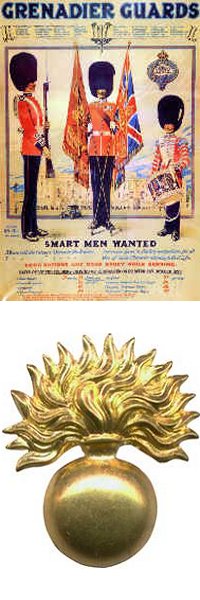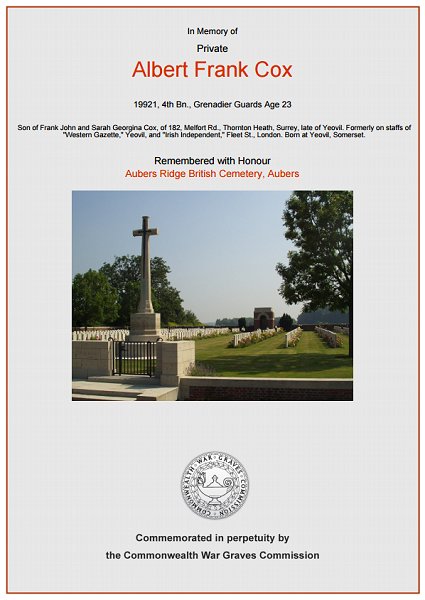yeovil at War
Albert Frank Cox
Killed in action on the Western Front
Albert Frank Cox was born in the summer of 1892 at Yeovil, the eldest son of advertisement clerk Frank John Cox (b1870, Yeovil) and Sarah Georgina née Grimes (b 1869, Chelsea). In the 1901 census Frank and Sarah, together with their three sons Albert, Reginald Percy (b1895) and Harold J (b1899) at 68a Huish, immediately opposite the National Day School.
Albert's parents moved from Yeovil during the next few years to 182 Melfort Road, Thornton Heath, Surrey but Albert remained in Yeovil, and in the 1911 census 18-year old Albert was a boarder at 62 Huish with George Miller and his wife Mary. Albert, like his father before him, gave his occupation as an advertising clerk, working on the Western Gazette.
 Albert
also moved from
Yeovil and is
known to have
worked at the
Irish
Independent
newspaper in
Fleet Street,
London.
Albert
also moved from
Yeovil and is
known to have
worked at the
Irish
Independent
newspaper in
Fleet Street,
London.
He enlisted at Cockspur Street, Westminster, joining the Grenadier Guards. Guardsman Cox's Service Number was 19981 indicating that he enlisted at the beginning of October 1914.
It is not known in which battalion Albert served but he was later to transfer to the 4th (Service) Battalion, probably at the time of its formation on 14 July 1915 at Marlow.
The 4th (Service) Battalion went to France on 19 August 1915, joining 3rd Guards Brigade, Guards Division. Within a couple of weeks the battalion became embroiled in Battle of Loos (26 September – 8 October).
This was the British Army's contribution to the major Allied offensive launched simultaneously with the main French offensive in Champagne. It was the biggest British attack of 1915.
A continuous preliminary bombardment, which showered 250,000 shells on to the German defences over four days, had little real effect. Before sending in the infantry on the morning of 25 September 1915, the British released 140 tons of chlorine gas from 5,000 cylinders placed on the front line to make up for the ineffective artillery barrage. This was the first time the Allies had used the weapon, coming after the Germans employed gas to terrible effect at Ypres in April earlier in the year, and it was hoped it would annihilate the Germans at Loos. However a change in the direction of the wind at several points along the front blew the gas back into the British trenches, causing seven deaths and injuring 2,600 soldiers who had to be withdrawn from the front line. Initially the gas attack created panic among the Germans and close to 600 men were gassed. Despite the setbacks caused by the wind 75,000 British infantrymen still flowed out from the trenches when the order came. British losses at Loos were exceptionally high with 50,000 casualties, including at least 20,000 deaths.
Two weeks later the battalion took part in the Actions of the Hohenzollern Redoubt took place from 13–19 October 1915. The Hohenzollern Redoubt (Hohenzollernwerk) was a defensive strongpoint of the German 6th Army on the Western Front at Auchy-les-Mines near Loos-en-Gohelle in the Nord-Pas-de-Calais region of France. Named after the House of Hohenzollern, the redoubt was fought over by German and Allied forces. Engagements took place from the Battle of Loos (above) to the beginning of the Battle of the Somme on 1 July 1916. In the aftermath of the Battle of Loos, the 9th (Scottish) Division captured the strongpoint and then lost it to a German counter-attack. The British attack on 13 October failed and resulted in 3,643 casualties, mostly in the first few minutes. In the British Official History, J. E. Edmonds wrote that "The fighting (from 13–14 October 1915) had not improved the general situation in any way and had brought nothing but useless slaughter of infantry".
Having survived these two major actions, Albert Cox was killed in the day-to-day fighting of the Western Front on 20 November 1915. He was aged 23 and was interred at Aubers Ridge British Cemetery, Aubers, Pas de Calias, France, Grave VIII.B.12.
His name was added to the War Memorial in the Borough in 2018.
gallery

The Commonwealth War Graves Commission's certificate commemorating Albert Cox.